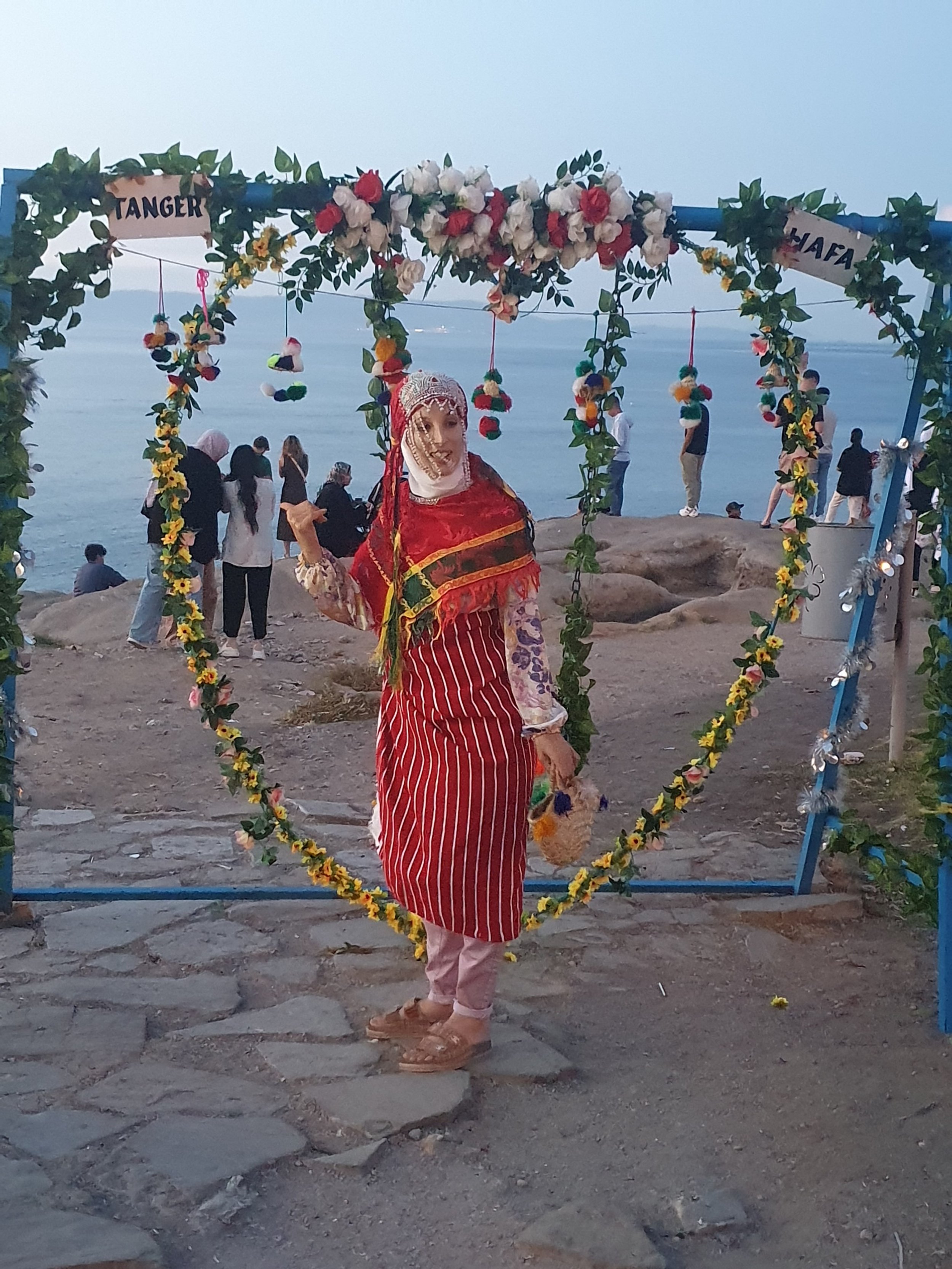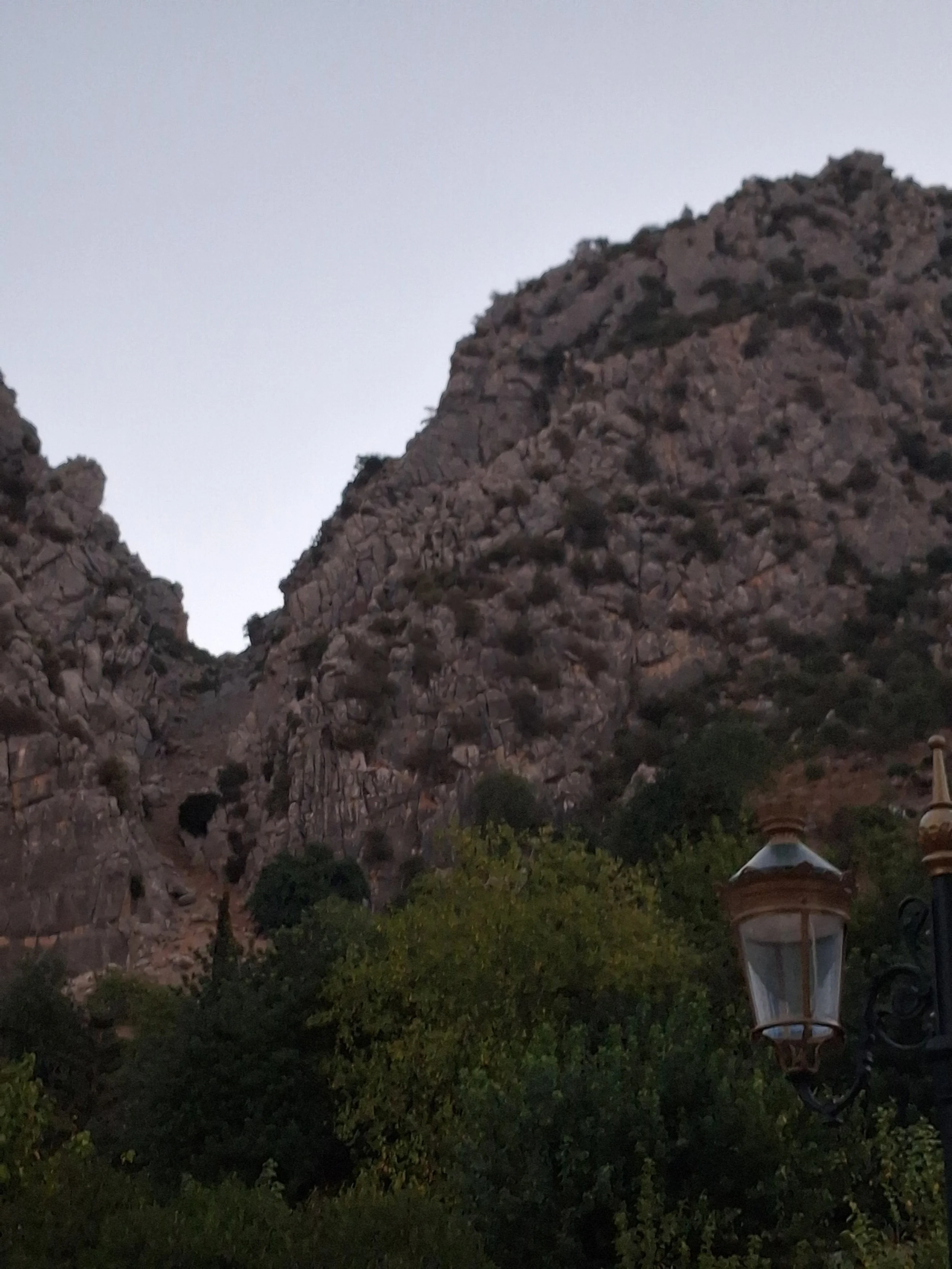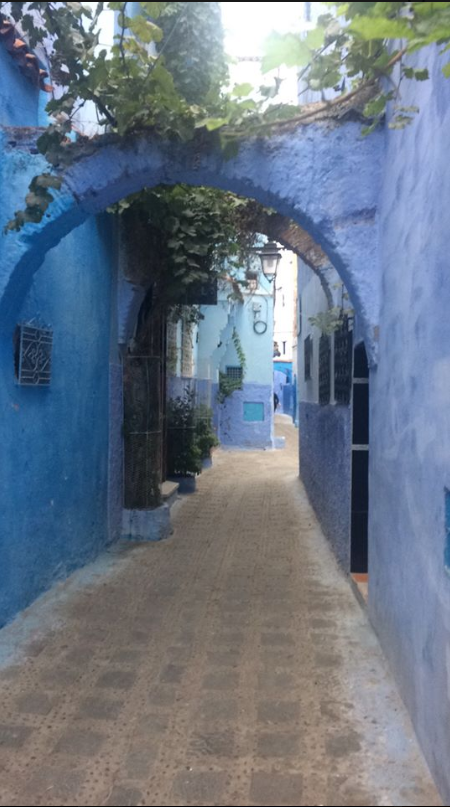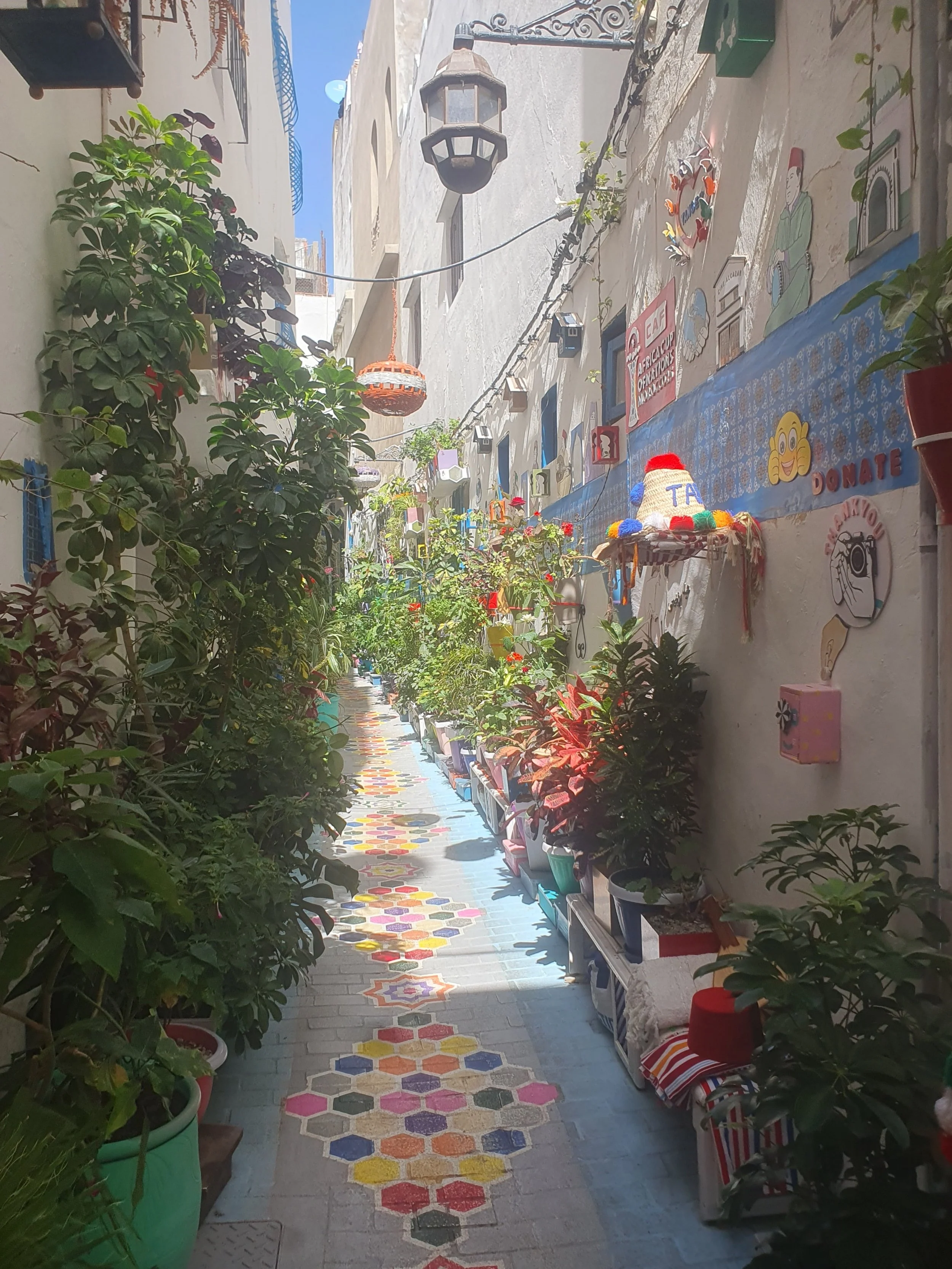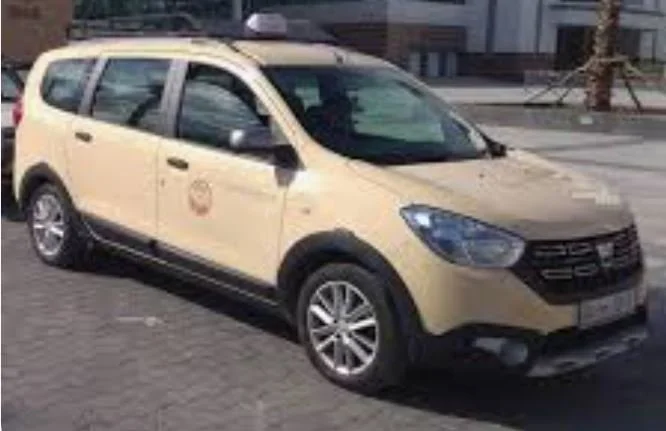The Blue City
A Day Trip from Tangier
Morocco’s Blue City
Chefchaouen
Is it really blue?
I’ve now visited twice – a longer stay in 2019 when I first arrived in Morocco, probably still getting over jet lag, a flight of 30 hours from Canberra/Sydney to London (including stop in Qatar), flight to Tangier and job interviews.
As it turns out, that first visit when I was intending to stay at least a year, fixed with year-long job and flat contracts and good prospects – well, one of the things about Tangier is that you never know what is going to happen. In that case, just after arrival everything fell apart. After two months I was packing my bags again and heading off to Europe and to get stuck in London for covid.
But my brief stay in Tangier did include a trip to Chefchaouen. (said shef-show-en)
Is it really blue? Like you wouldn’t believe!!! It is a treasure trove of photos to impress your most reticent great uncle.
No colour filters. This is what it actually looks like!
In the old medina – the maze of streets and alleyways in the old part of town – the bottom two metres of all the buildings are painted blue (to just above head height).
At least.
In some areas the whole wall is painted blue. Sometimes even the street you are walking on!
With slightly varying shades, with shadows on the walls, and steps which disappear up and out of sight and around corners – an invitation to all adventurers whose curiosity demands they explore to find out what is next along that pathway, just out of sight.
The blue pales in the sunshine in some spots, deepens like the sea in others catching the shadows, and reflecting back on itself for yet another shade. It is all kept fresh by a painting fiesta every couple of years, where everyone pitches in to repaint everything to keep it fresh.
Add to that some streets decorated with lovely contrasting deep green pot plants. And don’t forget the cats, who all oblige by posing for your album of photos.
In Morocco I find the angles and spaces between the medina homes a constant invitation for amazing photos – I must have taken the same photos a hundred times in some spots. Alleyways and stairs that sneak off around corners, beckon me. I love the old studded wooden doors with brass knockers, and the arched gates, doorways and window frames sometimes fixed with stained glass, which all echo of an intriguing and amazing part of the world.
Add to that the prettiest blue colouring in everything, and you get one of the most beautiful places I’ve been.
Why is Chefchaouen blue?
The second time I went to Chefchaouen was another story. For just one day in October 2025, and another movie, another misadventure.
If you come to Tangier without onward plans, be warned. You may think you are choosing, but it is Tangier which does the choosing!
My first stay I planned a year, and was gone in two months. My second visit was planned for two months. Three years later I “left”. Which is why I am still here! This time it was a planned visit of two weeks for a Chris Pratt series – Terminal List on Prime. But Tangier wasn’t letting me go so easily.
First I delayed for some health checks – which were more exhausting than the original problem. But at least I was given a 100% clean bill of health. Then I delayed to do a favour. And then to complete the wrap up of the favour. By then there was another movie – this the one in Chefchaouen.
It is a Moroccan series that screens every year in Ramadan, something fun that’s now in its 20th Ramadan year. This one (for Ramadan 2026) is a 33-episode series of 30-minute shows, weaving the story of 3 families in Chefchaouen. I was at the very beginning of the very first episode, and had to behave like a… tourist!
Luckily for me.
I’ve got it on good authority that it would not be a wise move for me to give up my day job to be an actor. My place is from the other side of the camera – maybe even to write a script.
So, with all my years of collecting trivia around Tangier, this brings us back to the question:
Why is Chefchaouen blue?
There are four reasons I have come across over time.
Watch the Goat’s Horns
Choof! Look! (Shooff)
Morocco isn’t Arabic. It is Amazigh, or Berber (derived from the word barbarian). The Berber people are from the Rif Mountains, and widely spread across this north western corner of Africa, including Algeria, Tunisia, and down to Mali in the south.
The colourful dress of the Berber women. This one is posing at the Phoenician tombs near Cafe Hafa in Tangier, with a backdrop of Spain.
That is also why Darija (Moroccan Arabic) is so far different from Arabic in the Levant. It is very heavily laced with Amazigh words and sounds (as well as French, Spanish in Tangier, Italian in Tunisia etc). Arabic speakers cannot understand Darija without learning how. It is a different language.
Choof means look (‘ch’ said sh), and chauoa (shower) means goat’s horns, referring to the shape of the hills above the town.
Its history is similar to many parts of northern Morocco. After the advent of Islam around 610 AD, the Arabic Moors swept across northern Africa in the late 600s during the conquests of the Arab Umayyad. The local Berber people initially resisted Islam, but over the centuries they were gradually converted.
The Arab Umayyad then crossed the strait into Spain in 711 – which explains the Alhambra in Granada and the mosque at Cordoba, the casabas (Spanish for kasbah, or castle), and Arabic influence of the architecture in southern Spain. They stayed until they (the Moors), together with the Jews were ejected by the Catholic Queen Isabella in 1492.
These quintessentially Arabic arches and carvings are part of the Alhambra in Granada in Spain. Its construction was started in 1238.
The Chefchauoen kasbah or castle was established by the Spanish in 1471 against the Portuguese, and was quickly settled by the Moors and Jews forced out of Spain. Morocco had a significant Jewish population for many centuries.
Morocco’s Jewish population went up to 250,000-350,000, but has been declining since 1948, when Israel paid governments – including the Moroccan government – for every Jew who left Morocco and resettled in Israel. The current population of Jews in Morocco is around 2000-3000. The Moroccan Jewish population in Israel is now around half a million today.
So…
Why is Chefchaouen blue? The first – and most appealing – theory of why Chefchaouen is blue is because blue is symbolically important to the Jews. Their prayer shawls are dyed with blue dye – tekhelel, which reminds them of God’s power. It is said that they painted the walls of their houses blue to honour God.
Ras Al-Maa – Head of the Mountain Spring
Chefchaouen seems to be all about water. The main square itself where the kasbah is, is called Place Outae Hammam. Originally a crossroads, it was logically the location of the most important feature in town – the hammam, or bath house.
This is a special treat in Morocco. Most Moroccans go on a regular weekly basis, or even more often – to slough off the old skin and inlaid dirt and keep their skin in peak condition.
The hammam may be gone, but the kasbah and its museum are still in the square. It was built in the Andalusian style (southern Spain), and includes the emir’s residence, towers, sheds and stables, a small mosque, a garden and a prison. The building used limestone and rammed earth. Uncharacteristically the archways use red bricks fired locally, red tiles on the roof, and wooden platforms from juniper and fir trees.
If you walk up to the top of the town, you will pass the communal laundry houses which are still used as gathering points by the women even today, as well as mills for grinding grain and pressing olives for oil.
Ras al-Maa is the movie location, with amazing views over the blue village. We got a complete view, starting with the views across the town and the early morning low clouds, through the day as the sun lit up the houses, and into the evening with one of Chefchaouen’s spectacular sunsets.
Shortly after first light in Chefchaouen.
This is another reason to visit – to drink some sweet Moroccan mint tea from one of the rooftops, and maybe an almond biscuit or few, and meditate over one of the beautiful sunsets for which Chefchaouen is famous.
On a more energetic level, the head of the mountain spring – the Ras Al-Maa – is a great spot for a half or full-day hike, and in the summer a swim. From the top of town where the movie location was, past the women chatting over their washing, and the various mills. Make sure to keep looking over your shoulder for views and photos. Then just follow the river on uphill.
The Ras Al-Maa or spring is the reason why you know that the water in Chefchaouen is safe to drink. Every city in Morocco is different, and you need to ask. Tangier has safe drinking water, and Chefchaouen – you cannot beat water straight from a spring!
Why is Chefchaouen blue? The second theory is as the name Ras Al-Maa suggests – the water. The blue is supposed to reflect the Mediterranean. This is an interesting theory, since you can’t even see the sea from Chefchaouen. It is instead famous for its sunsets over the goat’s horn shape of its lovely hills. I would have expected the village to have been red-yellow for the sunsets, or green for the surrounding hillsides, or red like the clay baked bricks used in the kasbah.
Tajine and Atay b’Naanaa
With the lovely warm climate of the Mediterranean – and in the northern Rif Mountains above sea level, an intense sun – the lifestyle for most of the year is very outdoors. Drink atay b’naanaa – tea with fresh mint. In most Moroccan cities, that means lined up in front of a café. But in Chefchaouen the business is from a rooftop with views of the afternoon setting sun, with some Moroccan almond biscuit treats.
Of course, this isn’t the only food you could explore in Chefchaouen. Tagines can be found everywhere – my favourite is the lamb one with prunes. Tagines are stewed meat and vegetables in an array of Moroccan spices, predominantly including spices such as cumin, cinnamon – yes, a savoury spice giving a great twist to the flavours – turmeric, cardamon, paprika, and ground coriander.
And something sweet, such as prunes with the lamb. Other tagines might have dried apricots, sultanas or raisins, or sweetened caramelized onion. There are many great tagine restaurants – just ask. But one place that I like is the Clock Café in the middle of Chefchaouen village. It has lovely rooftop views, and sometimes throws in menu treats like camel burgers, for the more adventurous.
Maybe try a cactus juice. In season, you can buy them on the street for 2 to 5 dirhams. The seller peels away the prickly skin so you just pick out the sweet fruit to pop into your mouth. I also love a pomegranate juice in October, or a freshly squeezed lemon with fresh mint. Fruit in Morocco is spectacular, some of the sweetest and best I have tasted anywhere.
Why is Chefchaouen blue? The third theory is that it makes you feel cooler in the summer. This is also an appealing reason, except that I would expect all of Morocco to be filled with villages painted blue, since all of it is hot.
Namoosa
Chefchaouen has your usual range of souvenirs, obviously with a Chaouen twist. There are the brilliantly coloured woven cloths which I manage to buy far too frequently for the space in my bag! There is the pottery which I also try to squeeze into my bag, quite unsuccessfully, as well as all the usuals including rugs. Uniquely, a lot in Chawan are produced by the local blind co-operative, which you can visit.
And the traditional robes or djelaba with hoods pulled up in the winter. I swear they were the inspiration for Star Wars Tusken Raiders on Tatooine (the nearby city called Tetouan also gives me pause to wonder). In winter I feel like I have giant echoes of them walking the streets of Tangier.
Winter tunics for sale, though not the hooded ones.
Trivia fact: The Tatooine home of Luke Skywalker was filmed in Tunisia, and the name Tatooine is thought to actually be derived from the Tunisian town of Tataouine (French spelling), or Tataween in Tunisian Darija.
Another interesting trivia fact, unrelated to Star Wars… or maybe not… is found in a closer look at the nice green hills that surround Chefchaouen. The biggest commercial crop here may surprise you – it is cannabis. Morocco has excellent hash, and available very cheaply. The smell is on many street corners. Although not strictly legal, most Moroccans have at some time smoked, and many smoke all the time.
Why is Chefchaouen blue? The fourth theory, that is quite popular, but getting into the realms of fantasy, is that the blue colour keeps the mosquitoes away – the namoosa. If this actually worked, I would have imagined most of the hot parts of the world being painted blue. But Chefchaouen is unique in its blueness.
However, it does also generate a significant hemp industry. Maybe find yourself a hemp bag with a Chefchaouen picture on it.
The Ramadan Series
The spectacular views of Chefchaouen from dawn through the midday sun to sunset, was not without its misadventures. I like doing the Moroccan movies, because so far they have had the best food. This one was no exception.
We spent an hour or so at dawn ooh-ing and aah-ing as tourists over the opening speech of a tourist guide. The rest of the day was just waiting. I happily read a large chunk of my Jack Reacher novel, sitting with a cat in the midday sun. Mid-afternoon, we got paid and sent off happy at the prospect of being back in Tangier before the anticipated 9pm.
40 minutes down the road, on the 2 ½ hour trip back, we got a phone call. We had to return to Chefchaouen – they hadn’t finished with us. There was another scene. We turned around, trundled back to Chawan. The car was full. With 5 of us, I scored the middle of the back seat…
Nearly 2 hours after leaving, we were back at Ras Al-Maa at the top of Chefchaouen. And we returned to the main pastime of extra work – waiting.
After about half an hour, it was official. They were finished for the day, and no, they didn’t need us after all. We had now got in a Chefchaouen sunset to match the morning scene’s sunrise, but movie days aren’t usually short. We had left Tangier at 4am, and didn’t get back until 9.30!
Why is Chefchaouen blue? – Spoiler Alert
I give you fair warning! If you are a romantic, here is the spot to stop reading. If you enjoyed the above reasons, from historic to absurd, stay with them. Because as a local I have had time to discover the truth about Chefchaouen, and it has none of the lovely images of the reasons given.
The reason there are so many theories may well be because the reality is mundane. I have met more than one person who was either from Chefchaouen, or visited there from Tangier as a child, maybe 50 years ago. The truth is, that in the 1970s, Chefchaouen was not blue.
The blue is a thing that has grown over time. The locals realized it was an attraction, and built on it, painting more and more of their streets blue. Tangier medina has spots like this now too, if you wander off the main souvenir streets – little alleys painted blue and filled with lush green plants, and always cats.
This pretty medina street is not in Chefchaouen, but in Tangier - maybe the beginnings of new rumours.
And to be honest, they have created a beautiful place to visit. I wonder, in the end, as the truth gets buried by the rumours and stories, does it really matter? Even in the winter it is a photo album of delights. It is a tranquil place to spend a day, or even a few.
There is a lot to be said for meditating on a beautiful sunset over the goat’s horned mountains, Moroccan mint tea and some almond biscuit treats, maybe a hike up to the spring for a swim in the Rif mountains.
And the secret of the truth can stay between us if you wish.
Just take your album of amazing photos, repeat your favourite theory, and make your friends and family want to visit what is in the end one of the prettiest places I’ve ever been.
How to get to Chefchaouen from Tangier?
Most of the information is distressingly set out by people who fly through. The information is bad, because they didn’t stay long enough to find out how things actually work in Morocco. The best way to get there is the way the locals do it. By the grand taxis.
Catch a share blue petit taxi to the old CTM bus station, or Autasa, about a 10-minute ride behind the train station along the west side of the train tracks. Here someone will direct you to the appropriate fawn coloured grand taxi.
These taxis are like mini buses. They have fixed routes, and fixed fares. The advantage is that they are smaller and more comfortable, and go as soon as they are full – 6 people, rarely a wait of more than 10 or 20 minutes. The fare to Chefchaouen is 70 dirhams per seat.
A grand taxi, with its red logo on the door. They will sometimes pose as normal taxis, so always check the price first. The grand taxis will always start when they have their full quota of 6 passengers.
If you make an early start, you can do a day return trip – about 2 hours 17 minutes each way. The return is from the spot where they drop you off. Alternatively, book somewhere overnight, relax and enjoy the sunset.
There are also buses, but the taxis are more comfortable, more frequent, faster, don’t require pre-booking, and around the same price.



